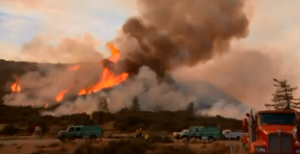Brutal winds that fueled southern California wildfires finally began to ease Saturday, giving residents and firefighters hope for a respite as the destructive toll of the blazes came into focus.
After a five-day siege, some Californians were finally able to return home to inspect the damage wrought by the wildfires, which forced hundreds of thousands of people to flee and destroyed more than 850 structures including multimillion-dollar mansions.
Despite the intensity of the fires that raged on multiple different fronts — stretching from areas north of Los Angeles down to the San Diego region — authorities have reported only one fatality.
With gusts of up to 60 miles per hour (95 kilometers per hour), relentless seasonal winds had continued to stoke the fires Friday, spitting embers and creating “extreme fire danger”.
“There’s still tons and tons of hot spots out there,” Captain Jon Heggie of the California Department of Forestry and Fire Protection (Cal Fire) said early Saturday.
A “red flag” warning issued by the National Weather Service is in effect until 8:00 pm Sunday (0400 GMT).
The strongest winds are expected in the San Diego County mountains and foothills, with gusts over 60 miles per hour, the NWS predicted.
Winds were expected to calm somewhat but a red alert was extended into Sunday due to expected low humidity.
And despite the easing of the winds, meteorologists warned that smoke and ash could linger, prompting several counties to maintain air-quality warnings.
The new normal
In the mountain town of Ojai the air-quality index was hovering over 500 — at the top of the “hazardous” scale — as fumes from the “Thomas” fire hung trapped by the mountains.
Since erupting in Ventura County late Monday, that blaze has seared 155,000 acres (60,000 hectares) and destroyed over 500 structures, but an area fire department spokesperson said Saturday containment should improve “after aggressive fire fighting” the day prior.
Governor Jerry Brown said many scientists believe more extreme fire seasons are part of the pinch of climate change.
“This is kind of the new normal. We’re facing a new reality in this state where fires threatens people’s lives, their property, their neighborhoods,” Brown said at a fairgrounds briefing
“We know from changing climate that (fires) are going to exacerbate everything else (and) in the longer term, I think we have to think through how are we going to adjust ourselves to nature as it changes,” Brown said, his approach a stark contrast to that of US president Donald Trump, a doubter of climate change.
“We can’t expect nature to adjust to our needs,” Brown added.
The material cost of fire suppression efforts has skyrocketed to some $17 million, Ventura officials estimated.
The “Skirball” fire — near the affluent, star-studded Bel Air district — was 75 percent contained after engulfing entire hillsides in flames and scorching over 400 acres.
‘Considerable progress’
Firefighters contained 85 percent of the “Creek” fire — the largest blaze that menaced the LA region, which roared through more than 15,000 acres — while the nearby “Rye” fire, which has burned over 6,000 acres, was 80 percent contained.
The “Liberty” fire was 100 percent contained — meaning “a control line has been completed around the fire which can reasonably be expected to stop the fire’s spread” — as of Saturday night, the Murrieta Fire Department said.
California’s state fire agency said “favorable conditions helped make considerable progress today” but warned that “residents should remain vigilant as conditions can change quickly.”
#ThomasFire [update] Hwy 150 and Hwy 126, north of Santa Paula (Ventura County) is now 155,000 acres and 15% contained. Unified Command: CAL FIRE, Ventura County Fire, Los Padres National Forest and Ventura City Fire. https://t.co/vfLtDXYjzO pic.twitter.com/9mHNmSrKJl
— CAL FIRE (@CAL_FIRE) December 10, 2017
Authorities near San Diego — where the “Lilac” fire had rapidly charred more than 4,000 acres in a blaze that is now 50 percent contained — issued a similar notice, saying improvement was expected but urging residents to remain on high alert.
The fire claimed the lives of more than two dozen racehorses after tearing through eight barns.
In Fallbrook, in northern San Diego County, houses were destroyed and ravaged trees lay horizontal.
US President Donald Trump has issued a state of emergency in California, authorizing the release of federal funds.
The week’s infernos capped California’s deadliest year ever for wildfires. More than 40 people died in October when fires swept through the state’s wine-producing counties north of San Francisco.
Source: france24.com
Ask me anything
Explore related questions





